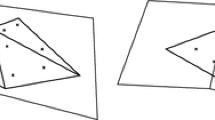Abstract
Finite cover method (FCM) is extended to elastoplasticity problems. The FCM, which was originally developed under the name of manifold method, has recently been recognized as one of the generalized versions of finite element methods (FEM). Since the mesh for the FCM can be regular and squared regardless of the geometry of structures to be analyzed, structural analysts are released from a burdensome task of generating meshes conforming to physical boundaries. Numerical experiments are carried out to assess the performance of the FCM with such discretization in elastoplasticity problems. Particularly to achieve this accurately, the so-called mortar elements are introduced to impose displacement boundary conditions on the essential boundaries, and displacement compatibility conditions on material interfaces of two-phase materials or on joint surfaces between mutually incompatible meshes. The validity of the mortar approximation is also demonstrated in the elastic-plastic FCM.
Similar content being viewed by others
References
Belytschko T, Lu YY, Gu L (1994) Element free Galerkin methods. Int J Numer Meth Eng 37: 229–256
Liu WK, Jun S, Zhang YF (1995) Reproducing kernel particle methods. Int J Numer Meth Eng 20: 1081–1106
Fernándes-Méndez S, Huerta A (2004) Imposing essential boundary conditions in mesh-free methods Comput Meth Appl Mech Eng 193: 1257–1275
Melenk JM, Babuška, I (1996) The partition of unity finite element method: basic theory and applications. Comput Meth Appl Mech Eng 29: 289–314
Babuška I, Melenk JM (1997) The partition of unity method. Int J Numer Meth Eng 40: 727–758
Strouboulis T, Babuška I, Copps K (2000) The design and analysis of the generalized finite element method. Comput Meth Appl Mech Eng 181: 43–69
Strouboulis T, Copps K, Babuška I (2001) The generalized finite element method. Comput Meth Appl Mech Eng 190: 4081–4193
Strouboulis T, Zhang L, Babuška I (2003) Generalized element method using mesh-based handbooks: application to problems in domains with many voids. Comput Meth Appl Mech Eng 192: 3109–3161
Belytschko T, Black T (1999) Elastic crack growth in finite elements with minimal remeshing. Int J Numer Meth Eng 45: 601–620
Belytschko T, Parimi C, Moës N, Sukumar N, Usui S (2003) Structured extended finite element methods for solids defined by implicit surfaces. Int J Numer Meth Eng 56: 609–635
Wells GN, Sluys LJ (2001) A new method for modeling cohesive cracks using finite elements. Int J Numer Meth Eng 50: 2667–2682
Shi GH (1991) Manifold method of material analysis. Transactions of the 9th Army Conference On Applied Mathematics and Computing, Report, No.92–1, U.S. Army Research Office
Shi GH (1997) Numerical Manifold Method. In: Proceedings of the 2nd International congress on analysis of discontinuous deformation, pp 1–35
Ohtsubo, H, Suzuki K, Terada K, Nakanishi K (1997) Utilization of finite covers in the manifold method for accuracy control. In: Proceedings of the 2nd international conference on analysis of discontinuous deformation, pp 317–322
Terada K, Asai M, Yamagishi M (2003) Finite cover method for linear and nonlinear analyses of heterogeneous solids. Int J Numer Meth Eng 58: 1321–1346
Leveque RJ, Li Z (1994) The immersed interface method for elliptic equations with discontinuous coefficients and singular sources. SIAM J Numer Anal 31: 399–417
Glowinski R, Pan T, Periaux J (1994) A fictitious domain method for Dirichlet problem and applications. Comput Meth Appl Mech Eng 111: 283–303
Terada K, Kurumatani M (2004) Performance assessment of generalized elements in the finite cover method. Finite Elem Anal Design 41: 111–132
Belgacem FB, Hild P, Laborde, P (1998) The mortar finite element method for contact problems, Mathl Comput Modelling 28: 263–271
McDevitt TW, Laursen, TA (2000) A mortar-finite element formulation for frictional contact problems. Int J Numer Meth Eng 48: 1525–1547
Becker R, Hansbo P, Stenberg R (2003) A finite element method for domain decomposition with non-matching grids, Mathematical Modelling and Numerical Analysis 37, 209–225.
Simo JC, Laursen TA (1992) An augmented Lagrangian treatment of contact problems involving friction. Comput Struct 42: 97–116
Stein E, Wriggers P, Rieger A, Schmidt M (2002) Benchmarks. In: Error-controlled Adaptive Finite Elements in Solid Mechanics. (ed/ Stein E, John Wiley & Sons, Ltd. New York): 385–404
Terada K, Asai M (2004) Finite cover method for physically and geometrically nonlinear problems. In: Griebel M, Sshweitzer MA (eds), Meshfree methods for partial differential equations, second International workshop, Universitat Bonn, Germany, September 15–17, Lecture notes in computational science and engineering. Springer, Berlin Heidelberg New York
Author information
Authors and Affiliations
Corresponding author
Rights and permissions
About this article
Cite this article
Kurumatani, M., Terada, K. Finite cover method with mortar elements for elastoplasticity problems. Comput Mech 36, 45–61 (2005). https://doi.org/10.1007/s00466-004-0641-6
Received:
Accepted:
Published:
Issue Date:
DOI: https://doi.org/10.1007/s00466-004-0641-6




